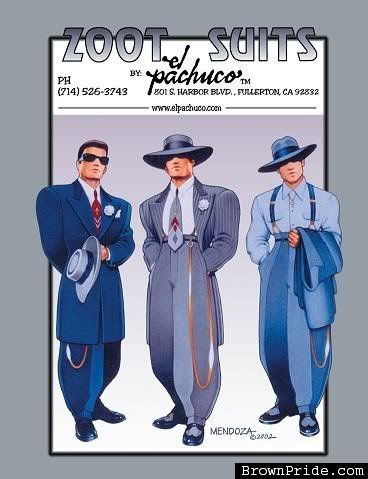 In a decade of the 1940s, when conformity was the norm, there were emerging subcultures that sported flashy suits to express their individuality. Zoot suits became especially popular among Hispanic and African American youth cultures in the United States. A similar sub-culture would emerge in Britain in the 1950s and those Englishmen who sported such flashy suits were called Teddy Boys, a throwback to the Dandies of the Edwardian Era. In the U.S., flashy suits were also widely popular among musicians and gangsters. The U.S. War Board came to view flashy suits as unpatriotic and wasting raw materials that could have been used to support the war effort. The resentment of this new subculture by mainstream society sparked the famous zoot suit riots mostly between white sailors who resented the flashy suits and the rising population of Mexican Americas immigrants in southern California. Like the U.S. War Board, many in society viewed the new flashy suits as a waste of raw material that could have gone to support the war. During the riots, African Americans also sported flashy suits and hence they became the target of attacks by white sailors as well.
In a decade of the 1940s, when conformity was the norm, there were emerging subcultures that sported flashy suits to express their individuality. Zoot suits became especially popular among Hispanic and African American youth cultures in the United States. A similar sub-culture would emerge in Britain in the 1950s and those Englishmen who sported such flashy suits were called Teddy Boys, a throwback to the Dandies of the Edwardian Era. In the U.S., flashy suits were also widely popular among musicians and gangsters. The U.S. War Board came to view flashy suits as unpatriotic and wasting raw materials that could have been used to support the war effort. The resentment of this new subculture by mainstream society sparked the famous zoot suit riots mostly between white sailors who resented the flashy suits and the rising population of Mexican Americas immigrants in southern California. Like the U.S. War Board, many in society viewed the new flashy suits as a waste of raw material that could have gone to support the war. During the riots, African Americans also sported flashy suits and hence they became the target of attacks by white sailors as well.
This was the first time that mainstream America had come across a subculture that perceived and thought differently than the average American. Whereas before, underground movements were hidden to keep the ire of mainstream society at bay, flashy suits drew other groups out in the forefront of mainstream society. From the forties onward, subcultures would become more visible with flashy youth culture in the fifties, the hippie movement of the sixties and so on. The war years witnessed a drawback in fashion when it came to supporting the war, but many people outside the mainstream fabric of American society chose flashy suits to express themselves regardless of society’s disapproval. At a time where discrimination was rampant, ethnic groups such as African Americans, Hispanics and some Asian groups saw flashy suits as a form belonging and having some measure of power in their own lives. The people who were brave enough to sport such flashy suits should be commended at a time when anything that defied conformity and sacrifice became frowned upon.
Flashy suits can be seen today in many music groups and even subcultures such as the Japanese mafia who regularly flaunt flashy suits to show their status and sense of belonging to the organized crime world. If you ever go to Japan and spot a young man sporting a flashy suit then odds are you are looking at a yakuza foot soldier.
No comments:
Post a Comment